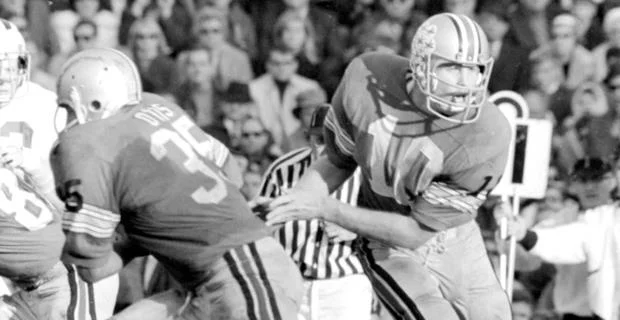In 1981, Ohio State defeated Michigan 14–9 and shared the Big Ten championship because to Art Schlichter’s legs and a strong defensive effort.
In 1981, the storied rivalry between Ohio State and Michigan produced another unforgettable chapter. The Buckeyes, led by quarterback Art Schlichter and anchored by a determined defense, battled their way to a hard-fought 14–9 victory over the Wolverines. That win not only secured bragging rights over their fiercest rival but also earned Ohio State a share of the Big Ten championship. The game was a showcase of grit, resilience, and the power of leadership, with Schlichter’s legs and the Buckeye defense making all the difference on a chilly autumn afternoon.
The stakes for the 1981 edition of “The Game” were as high as ever. Both teams entered the contest with the Big Ten crown hanging in the balance. The Buckeyes, under head coach Earle Bruce, knew that a victory over Michigan would cap their regular season with a title and a trip to the Rose Bowl. For Schlichter, a senior in his final matchup against Michigan, this was a chance to cement his legacy as one of Ohio State’s great quarterbacks. The Wolverines, coached by the legendary Bo Schembechler, sought to deny Ohio State that opportunity and claim the crown for themselves.
From the opening kickoff, it was clear that this would be a game defined not by flashy passing attacks or offensive fireworks, but by tough defense, field position, and timely plays. Both teams struggled to sustain drives early, with each defense showing discipline and tenacity. The Buckeyes’ defense, in particular, came out with intensity, clogging up running lanes, pressuring Michigan quarterback Steve Smith, and refusing to allow the Wolverines to establish rhythm.
Art Schlichter’s performance in this game may not have dazzled in the passing column, but it was his poise and ability to make plays with his legs that ultimately turned the tide. Throughout the afternoon, Schlichter found ways to extend plays, escape pressure, and pick up crucial first downs with timely scrambles. His mobility kept Michigan’s defense off balance and allowed the Buckeyes to control the tempo at key moments. While Schlichter threw for modest yardage, his leadership and ability to make something out of nothing repeatedly frustrated the Wolverines.
The game’s first major break came in the second quarter. After a series of exchanges that kept the game scoreless, Schlichter engineered a drive that showcased his versatility. He mixed short passes with option runs, gradually wearing down the Michigan front. The drive culminated in a touchdown that gave Ohio State the first lead of the afternoon. Schlichter’s ability to read the defense and make the right decisions with the ball proved decisive on that possession. The Buckeyes seized momentum, and the partisan crowd in Ann Arbor began to feel the tension rise.
Michigan responded with a field goal before halftime, narrowing the margin to 7–3. The Wolverines’ drive showed flashes of their offensive potential, but again, the Ohio State defense tightened near the red zone. Linebackers, defensive backs, and linemen swarmed to the ball, preventing big plays and forcing Michigan to settle for three points instead of seven. That red-zone stand would loom large as the game progressed.
The second half followed a similar script—hard-hitting, tense, and fiercely contested. Michigan continued to battle, and early in the third quarter, they added another field goal, drawing closer at 7–6. The Wolverines’ defense remained stout, limiting Ohio State’s opportunities and keeping their team within striking distance. Yet every time Michigan appeared poised to seize control, the Buckeyes’ defense answered the bell. The defensive line generated consistent pressure, and the secondary covered tightly, denying Michigan the chance to connect on game-changing plays.
Then came what would prove to be the pivotal drive of the contest. Schlichter, once again demonstrating his dual-threat capability, orchestrated a march down the field in the third quarter. Faced with critical third-down situations, Schlichter twice kept the drive alive with runs that moved the chains. His legs became the Wolverines’ nemesis, as he turned would-be sacks into positive yardage. The drive ended with Schlichter finding the end zone on a quarterback keeper, pushing Ohio State’s lead to 14–6 and delivering a body blow to Michigan’s hopes.
But Michigan refused to go quietly. They mounted another drive that resulted in their third field goal of the game, cutting the deficit to 14–9 early in the fourth quarter. The Wolverines’ defense then gave their team a chance by forcing a punt, setting up the possibility of a dramatic comeback. Yet the Buckeyes’ defense, as it had all game, rose to the occasion. With the Wolverines driving deep into Ohio State territory in the game’s final minutes, the Buckeye defenders stiffened. They forced Michigan into a desperate fourth-down attempt, and when the pass fell incomplete, the Buckeyes erupted in celebration.
That final defensive stand epitomized the day for Ohio State. The unit had bent at times, allowing Michigan to move the ball between the 20s, but it had never broken. Time after time, the Buckeye defenders made plays when they mattered most, whether it was a key tackle, a sack, or tight coverage that left Michigan frustrated. The victory was as much a testament to their collective will as it was to Schlichter’s heroics.
The final whistle signaled more than just the end of a football game. It marked the culmination of a season’s worth of work, sacrifice, and determination. Ohio State players celebrated their triumph not just as a victory over Michigan, but as a title-clinching moment. The 14–9 win secured a share of the Big Ten championship for the Buckeyes, affirming their status as one of the conference’s elite teams that year.
For Art Schlichter, the game added to his legacy as a Buckeye great. His statistics on the day would not light up the record books, but the manner in which he led his team—with toughness, intelligence, and timely playmaking—left an indelible mark. His legs were the difference in a contest where every yard was hard-earned and every first down precious. Schlichter had entered Ohio State as a heralded talent, and with this victory, he exited as a champion who had delivered when it mattered most.
For Ohio State fans, the win over Michigan in 1981 remains a cherished memory. The rivalry between the two programs has always been about more than football; it’s about pride, tradition, and the quest for supremacy in the Midwest. On that day, the Buckeyes stood tall, overcoming their greatest rival and securing a title that validated their hard work and belief.
The 1981 game also served as a reminder of what makes the Ohio State-Michigan rivalry so special. It wasn’t just about the star players or the final score—it was about the intensity, the strategy, and the heart shown by both teams. The players on both sides left everything on the field, and though only one team could emerge victorious, the game added to the rich tapestry of a rivalry that is second to none in college football.
Looking back, that 14–9 triumph was more than just a win. It was a defining moment in a storied rivalry, a celebration of team over individual, and a showcase of the power of perseverance. Ohio State’s 1981 victory over Michigan remains a symbol of Buckeye grit and determination, a game where defense and leadership came together to deliver a championship moment that fans would remember for decades to come.



